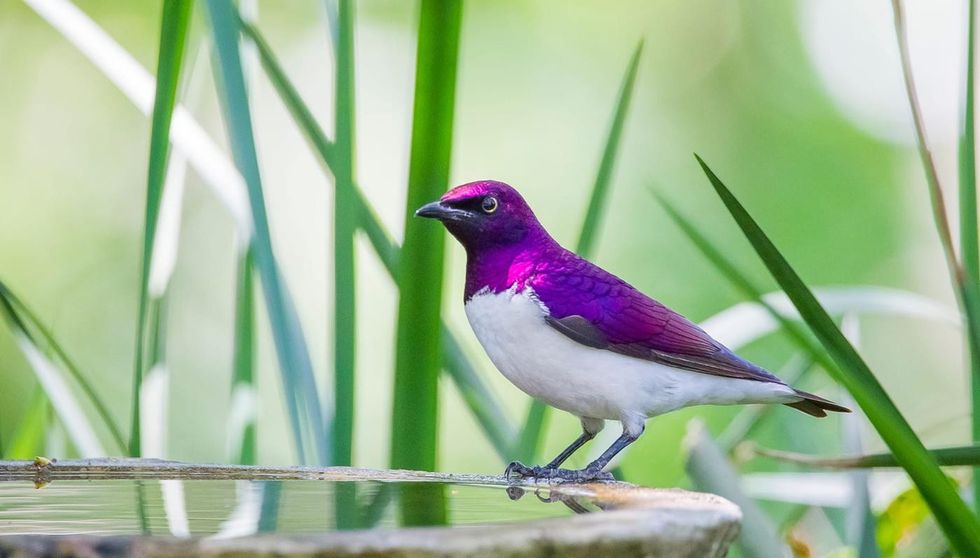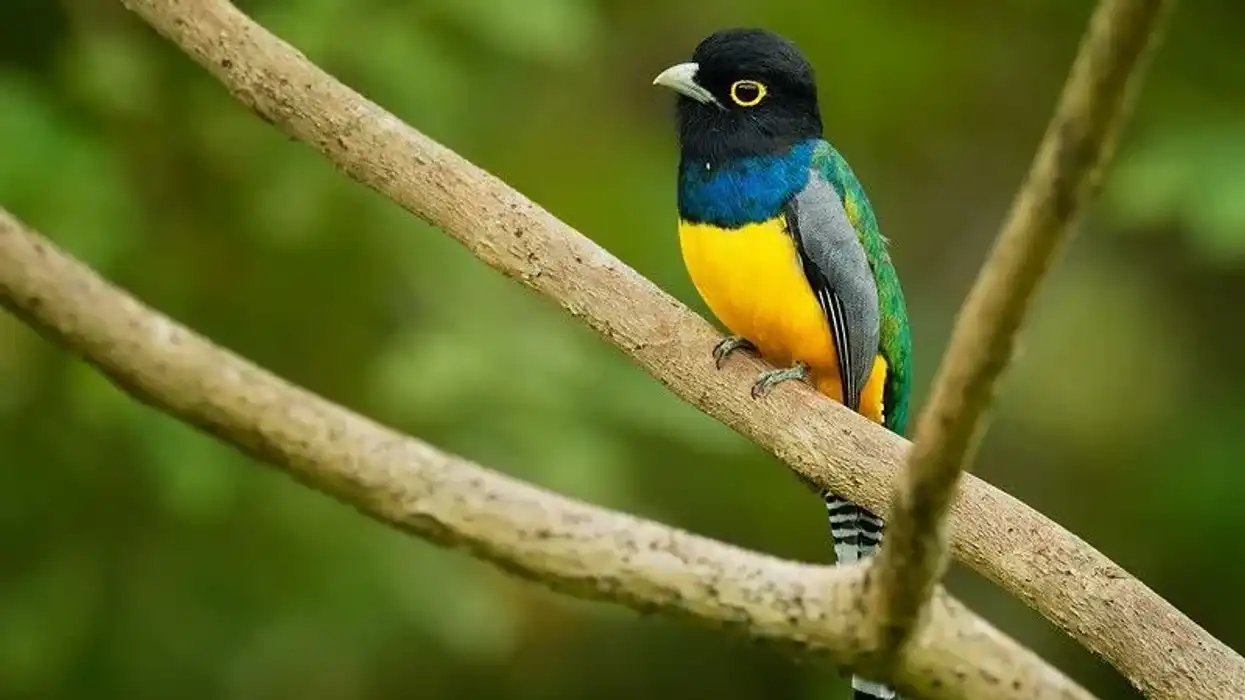If we made a list of some of the most beautiful birds in the family of starlings, then the Violet-Backed Starling will definitely stand out as unique!
They travel in small flocks, the male and female are both brown when they are younger, and they love to hunt insects off the ground.
Usually found evenly in distribution all over South Africa, these Starlings are a delight to see on a tree or flying across the sky looking for insects.
The Violet Backed Starling wings are their most remarkable feature which many have said appears to change color from dark violet to a lighter shade depending on whether it is a male for a female, and where in South Africa you spot these beautiful Starlings.
For information from the Violet-Backed Starling call, their family of Starlings, the female birds and their eggs, their travels in the dark and their breeding cycles, and their love for small insects and a Violet Backed Starling pet, read on!
This article will bring you up to date on this vibrantly colored member of the Starlings, their breeding, eggs, and life in general.
Curious to know more? Then other colorful birds like rose-breasted grosbeak and blue grosbeak will definitely catch your attention!
Violet-Backed Starling Interesting Facts
What type of animal is a Violet-Backed Starling?
The Violet-Backed Starling (Cinnyricinclus leucogaster) or Amethyst Starling is the type of bird.
What class of animal does a Violet-Backed Starling belong to?
The Violet-Backed Starling (Cinnyricinclus leucogaster) belongs to a class of birds.
How many Violet-Backed Starlings are there in the world?
The Violet-Backed Starling's global population is yet to be determined. Experts, on the other hand, describe the species as widespread and 'generally common' to 'locally abundant.' The International Union for Conservation of Nature (IUCN) listed it as in the Least Concern category due to its broad distribution and the fact that experts remain ignorant of particular threats.
Where does a Violet-Backed Starling live?
This Violet-backed Starling (Cinnyricinclus leucogaster) or Amethyst Starling lives in the savanna. The said bird species is widespread, ranging from the Arabian Peninsula's southwest to Sub-Saharan Africa. These birds mostly found in tropical forests and savannas. In general, the Violet-Backed Starling is found throughout both northern and southern equatorial forest
What is a Violet-Backed Starling's habitat?
This beautiful Violet-Backed Starling (Cinnyricinclus leucogaster) bird has been found in much of sub-Saharan African mostly in grassland, woodland, or riverine areas. Some scientific research says that this bird is partially migratory. This bird also adapted readily to a human-modified habitat, including farmland, orchards, plantations, and urban areas.
Who do Violet-Backed Starlings live with?
The Violet Backed Starling (Cinnyricinclus leucogaster) lives in small flocks and occasionally engages in sexual exclusion. These birds are very social, as they live together in colonies. Usually, they live in couples or families when they are breeding.
How long does a Violet-Backed Starling live?
The Violet Backed Starling (Cinnyricinclus leucogaster) or Amethyst Starling lives for about 15 years depending on their species and the place where they live.
How do they reproduce?
The Violet-Backed Starling (Cinnyricinclus leucogaster) creates nests in cavities like tree holes high off the ground, holes in river banks, even in old empty fencing pillars, filling the nests with leaves, dung, and additional plant matter. They have been seen reusing nests in the next breeding season.
The eggs are oval-shaped, spotted blue, incubated for a period of about two weeks. It is known that only the female incubates the eggs, but both parents feed the hatchlings.
What is their conservation status?
The conservation status of the Violet-Backed Starling (Cinnyricinclus leucogaster) is listed as Least Concern.
Violet-Backed Starling Fun Facts
What do Violet-Backed Starlings look like?
A small Violet Backed Starling (Cinnyricinclus leucogaster) is a shiny purple in its upper parts, with blackish-brown flight feathers, chin, and throat. The remainder of the belly is white in color.

*We've been unable to source an image of a Violet-Backed Starling and have used an image of a Common Starling instead. If you are able to provide us with a royalty-free image of a Violet-Backed Starling, we would be happy to credit you. Please contact us at hello@kidadl.com*
How cute are they?
This bird Looks like a beautiful, flying gemstone with magnificent shining colors. The male Violet Backed Starling (Cinnyricinclus leucogaster) has bright white bellies and incredible purple backs that become iridescent in the sunlight.
How do they communicate?
The Violet Backed Starling (Cinnyricinclus leucogaster) makes more than 15 types of different sounds and calls when communicating. The male is not known for his singing ability, but they do produce some sort of song during the nesting season. Sometimes coloration of Violet Backed Starling (Cinnyricinclus leucogaster) plays a role in inter and intraspecific communication.
How big is a Violet-Backed Starling?
This organism, also known as the Plum-colored Starling or Amethyst Starling, is the smaller of the Southern African starlings, measuring about 18 cm long. The myna is a bird belonging to the starling family which is native to southern Asia. The myna is bigger than Violet Backed Starlings, at about 23 cm in length.
How fast can a Violet-Backed Starling fly?
These birds have strong feet and their flight is strong and direct. Violet Backed Starling flying also happens for migration so must be a strong flight.
How much does a Violet-Backed Starling weigh?
The weight of Violet Backed Starling (Cinnyricinclus leucogaster) ranges from 39-56 g depending on the species.
What are their male and female names of the species?
The Violet Backed Starling (Cinnyricinclus leucogaster) is sexually dimorphic, which means there is a distinct difference in the appearance of the male and female but there is not any specific name for the genders of this plum-colored starling bird.
What would you call a baby Violet-Backed Starling?
A baby Violet Backed Starling (Cinnyricinclus leucogaster) or Amethyst Starling does not have any distinguished name.
What do they eat?
These birds are omnivores and like to eat fruits like mulberries, figs, and insects like bees, butterflies, wasps, and locusts. They are able to capture prey both on the wing or off tree branches.
These birds collect their food from the leaves and branches of trees and sometimes hawking prey in the air.
Their favorite food items included in its diet are termite alates, Celtis, cats-whiskers, fruits, shepherds-tree, and mistletoes. When food is limited, this bird is not ashamed to raid the nests of other bird species, stealing both nesting materials and hatchlings.
Are they friendly?
The Violet Backed Starling (Cinnyricinclus leucogaster) has a very aggressive nature and can force native birds to leave their territory.
Would they make a good pet?
Although the Violet-Backed Starling (Cinnyricinclus leucogaster) is a wild bird, they are easy to train and keep as pets. Once bonded with a keeper, they will be affectionate and get cuddly with their owner.
Did you know...
The migrating Violet Backed Starling purple birds starling could disperse the ingested seeds a lot farther on the ground.
The Plum-coloured backed Starling (Cinnyricinclus leucogaster) imitates a wide range of avian animals and has a range of about 15–20 distinct impersonations. They also mimic a few other noises besides those of wild birds. Calls of diverse organisms or those with simple frequency structures and no amplitude modulation are selectively imitated.
The feather gets its color due to tiny follicles in the outer skin layer which produce keratin proteins that form the feathers. Each 'hair' is represented by a barb, which branches perpendicularly into barbules. These barbules then divide into barbicels. The barbicels of the adjacent barbules hook together to form the framework of the feather.
The intrinsic coloration of the plumage is the result of nanoscale combinations of different components. That is keratin plaques, melanosomes, and the air within the feather barbules.
Of course, feathers within the same bird species may have various shades due to different processes and pigments. Moreover, it is normal for the same feathers to exhibit a mix of both processes. This is the reason why these birds have brighter or more saturated colors.
What is another name for a Violet-Backed Starling?
The Violet Backed Starling (Cinnyricinclus leucogaster) also goes by the names Plum-colored Starling and Amethyst Starling. This bird is the tiniest of the Southern African starlings. The Violet Backed Starling (Cinnyricinclus leucogaster) is a popular breeder and is not listed as a threatened species.
What's the difference between the male and female Violet-Backed Starling?
The genders of this plum-colored starling are highly sexually dimorphic, meaning that the male and female birds have distinct physical features. The adult male is brilliantly colored, with lustrous shiny plum-violet feathers running down the middle of his back, feathers, ears, and esophagus, and brilliant white on the remainder of his frame.
Females and young have a striped brown and polish coloration that is easily mistaken with that of thrush, another species of bird.
Here at Kidadl, we have carefully created lots of interesting family-friendly animal facts for everyone to discover! Learn more about some other birds including Caspian tern, or swallow-tailed kite.
You can even occupy yourself at home by drawing one on our Violet backed starling coloring pages.










